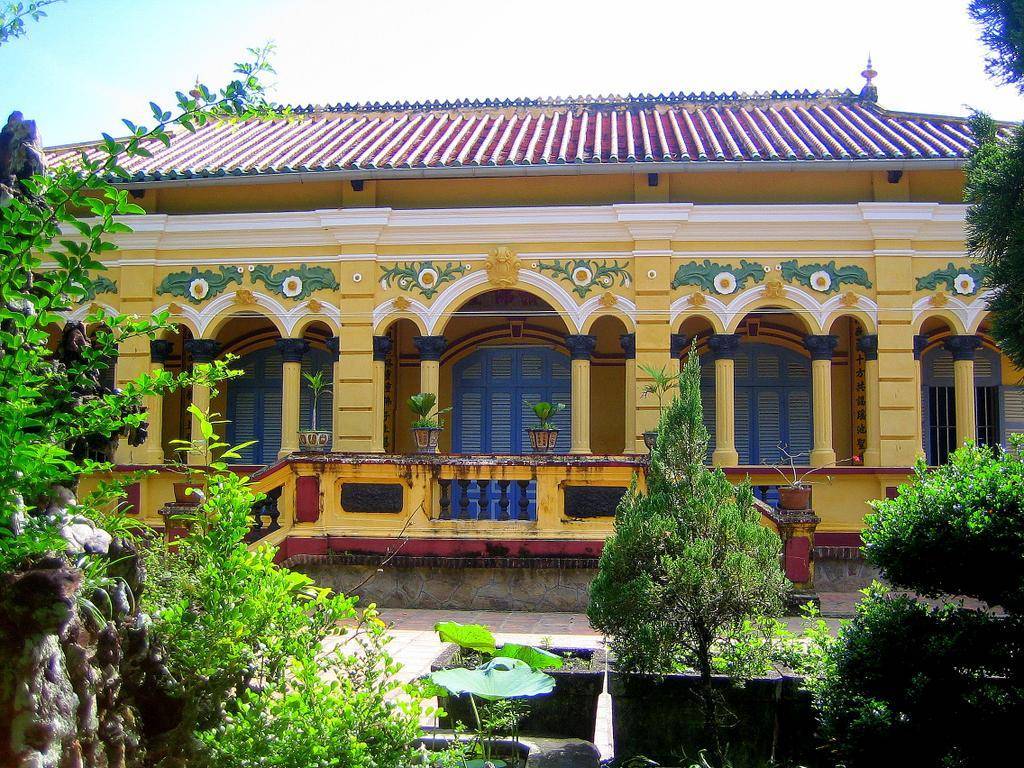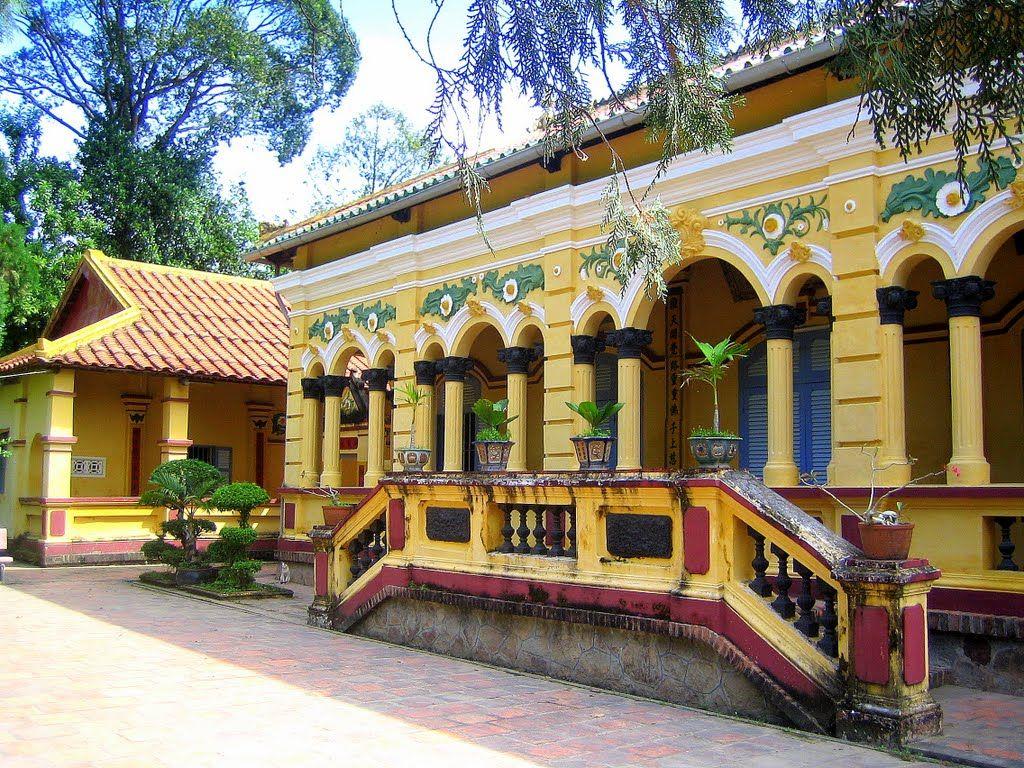When traveling to Can Tho to the land of Tay Do among many attractive attractions, visitors cannot ignore an extremely meaningful spiritual tourist destination that is Nam Nha Pagoda. Visitors come to the temple not only to worship and pray for peace, but also to admire the unique architecture and learn about the heroic history of the nation, which is associated with the patriotic movement of Vietnamese scholars. The pagoda was recognized as a revolutionary historical site on January 25, 1991.
Nam Nha Temple
Nam Nha Pagoda is located at 612 Cach Mang Thang Tam Street in Bui Huu Nghia Ward, Binh Thuy District, Can Tho City. In front of the pagoda is the Binh Thuy river with the silhouettes of great trees, opposite is the majestic ancient Binh Thuy communal house. The pagoda is only about 6km from the center of Can Tho city, visitors can reach the pagoda by river and by road very conveniently.
The fee in front of the temple is Binh Thuy river, opposite Dinh Binh Thuy
The pagoda was built by Nguyen Giac Nguyen in 1895, formerly a traditional medicine shop named Nam Nha Duong, later rebuilt and renamed Nam Nha Pagoda, both a place of worship and the headquarters. of the Dong Du movement (1907-1940) initiated by Phan Boi Chau. During the resistance war against the French, the pagoda was a place to practice more, nurture the patriotic movement and produce literati masters with patriotism and indomitable spirit against foreign invaders. During the difficult and arduous years of the revolution, Special Commissar of Hau Giang, Southern Party Committee of Cochinchina chose this place as a contact point for revolutionary organizations in the whole region.
Temple gate
Nam Nha pagoda follows the Minh Su sect, so it is also known as the Minh Su temple to worship the Three religions: Buddha Shakyamuni, Confucius and Lao Tzu, originated in China, appeared in Can Tho around the end of the 19th century and the beginning of the 20th century. . The former Nam Nha or Dao Minh Su pagoda, as well as other Buddhist temples in Vietnam, advocated vegetarianism and remembrance of the Buddha, but did not shave their heads, did not have monks, and did not wear brown robes. Good men and women who come to worship the Buddha can wear whatever clothes they want, as long as they are discreet and dignified.
The temple focuses on teaching Buddhists to cultivate their minds, nurture their nature, live simply, “minimum desire, tri-sense”, self-reliance in production to survive and develop. Until now, if visiting Nam Nha pagoda on the occasion of a certain worshiping ceremony, tourists still feel that simple lifestyle. Even though it’s crowded with people coming in and out, there’s always a quiet atmosphere
Nam Nha Pagoda is located in a spacious campus surrounded by a large garden with shady ancient trees, stretching to the banks of the Binh Thuy River. Including main items: Main hall, Dong Lang house and Tay Lang house; surrounded by park embankments, gates, fences. Overall architecture, construction items are balanced and solid, not only beautiful in architecture but also in harmony with the natural landscape.
Surrounding the pagoda is a yellow whitewashed fence with a brick and tiled entrance gate, with a three-character kanji as Nam Nha Duong. On both sides of the gate, there are two parallel sentences with the first two characters being Nam and Nha.
“The cause of the southern land, the wisdom of holding the sound of enlightenment”
Nha Dinh invites good guests, Bodhi takes the image of a Zen subject”.
Translation:
“South of the cause, the sound of the Bat Nha lute is in the realm of enlightenment.
And Nha Dinh invites good guests, the shade of Bodhi covers the meditation door.”
The arguments in the temple also have the content of teaching both religion and life, evoking patriotism and national sentiment.
The temple yard is paved with ship bricks. In the middle of the yard is a rockery over 2 meters high placed in a clear blue water tank built of dark red brick. In the middle of the yard, there is a monumental stele and many precious ornamental plants such as pine trees, old cypress trees, meticulously cared for to create a peaceful landscape.
Presbytery
The main hall of Nam Nha pagoda is a large majestic building located in the middle, called Dieu Tri Buu Dien. Consists of 5 compartments, roofed with yin and yang tiles, on top of which is a picture of a two-dragon statue. In particular, the façade of the main hall was built in the style of Asian-European architecture combined in the early 20th century, with many different features from the traditional pagoda style in the South at that time. Overall, the main hall has both the national architecture of the Chinese people and the colors of the French architecture at that time.
It has a unique Asian-European combination architecture that is different from other temples
Inside the main hall of Nam Nha pagoda, the central space is decorated very solemnly where the altar of the three religions shows the philosophy of the three religions: Buddhism, Confucianism, and Taoism. They all teach people to live a good life and lead a good life towards truth and beauty. The opposite table is the place to worship Tran Dan, the protector Bui Huu Sanh and the poet Bui Huu Nghia. The table on the right worships Quan Thanh De Quan, Lich Dai Patriarch and the founder of the pagoda is Nguyen Giac Nguyen. On both sides of the electric money, there are two incense tables with tablets of the abbots.
There is a special feature that from outside the main door, looking at the left hand side of Quan Thanh De Quan altar is an altar on which a large mirror is placed. When good men and women come to recite sutras and recite the Buddha’s name, they all kneel before this mirror. It is known that this mirror is used to remind believers to always reflect and reflect their true heart; On the other hand, it helps people standing with their backs turned out to detect strangers in time to be alert at each closed meeting during the anti-French period.
Behind the main hall is a long corridor, with 2 guest rooms. To the right and left of the pagoda are two rows of tiled houses, Can Dao Duong (Dong Lang house) for men and Khon Dao Duong (Tay Lang house) for women, connected to the kitchen.
The path behind the main hall
The fruit garden in the back seems to add a green and fresh look to the temple, and the tombs of the founders of the temple and the monks make visitors feel like going back in time. past, full of emotions.
The peaceful space of the temple
Nam Nha Pagoda is famous in the region not only for the beauty of its elegant architecture and tranquil surroundings, but also for being the site of silent activities to promote awareness and intellectual development. for the Vietnamese in the South. The people who take care of the temple through each period still persisted day and night quietly and elaborately during the process of living and practicing mindfulness.
Nam Nha Pagoda is a spiritual tourist destination associated with a very meaningful history.
If you have the opportunity to travel to the West, stop by the Nam Nha Pagoda in Can Tho, read a couple of verses, think a few sentences, and bow carefully before the spiritual values of a time when his father sacrificed himself for the ancestors. Dear Country.
Source: Collected internet.







